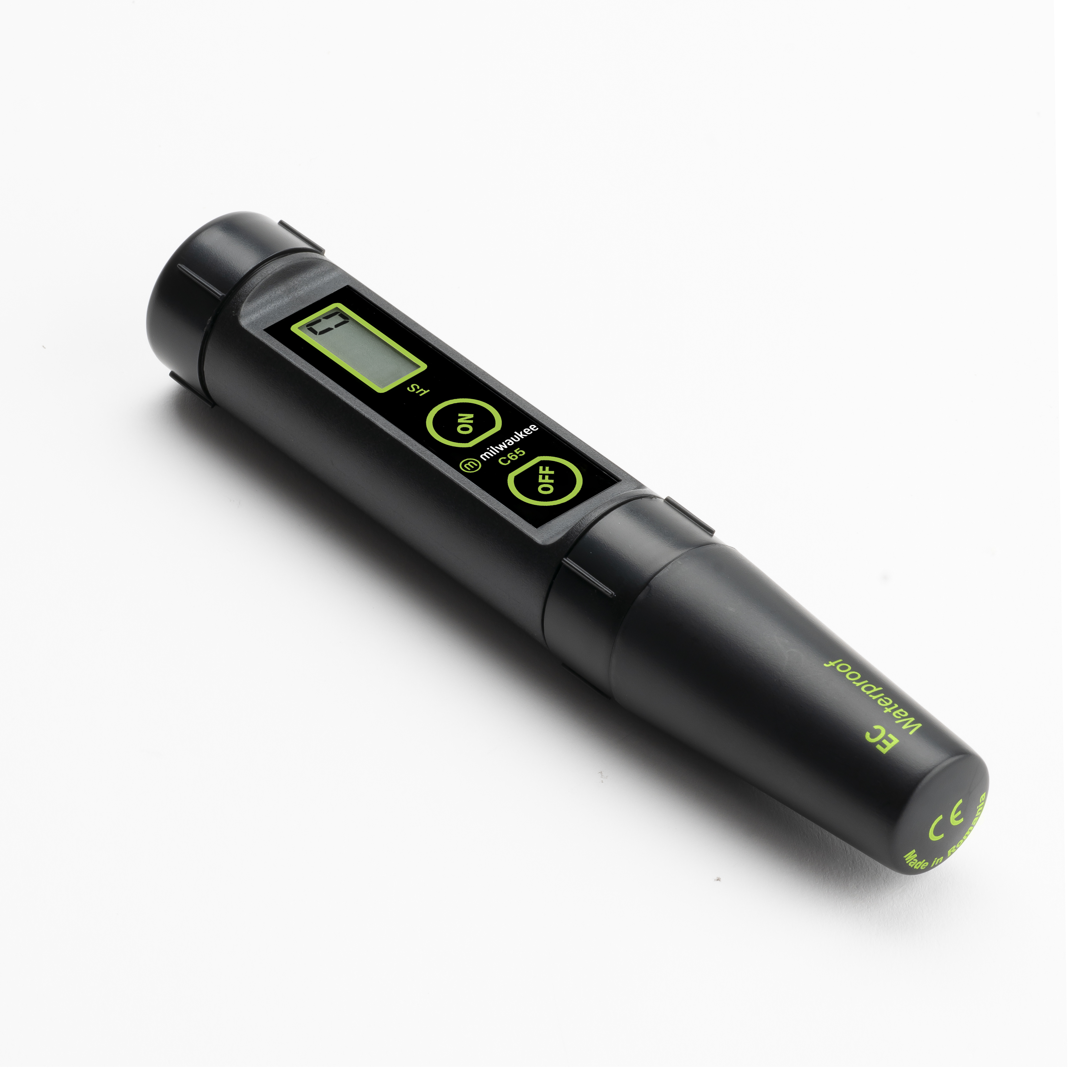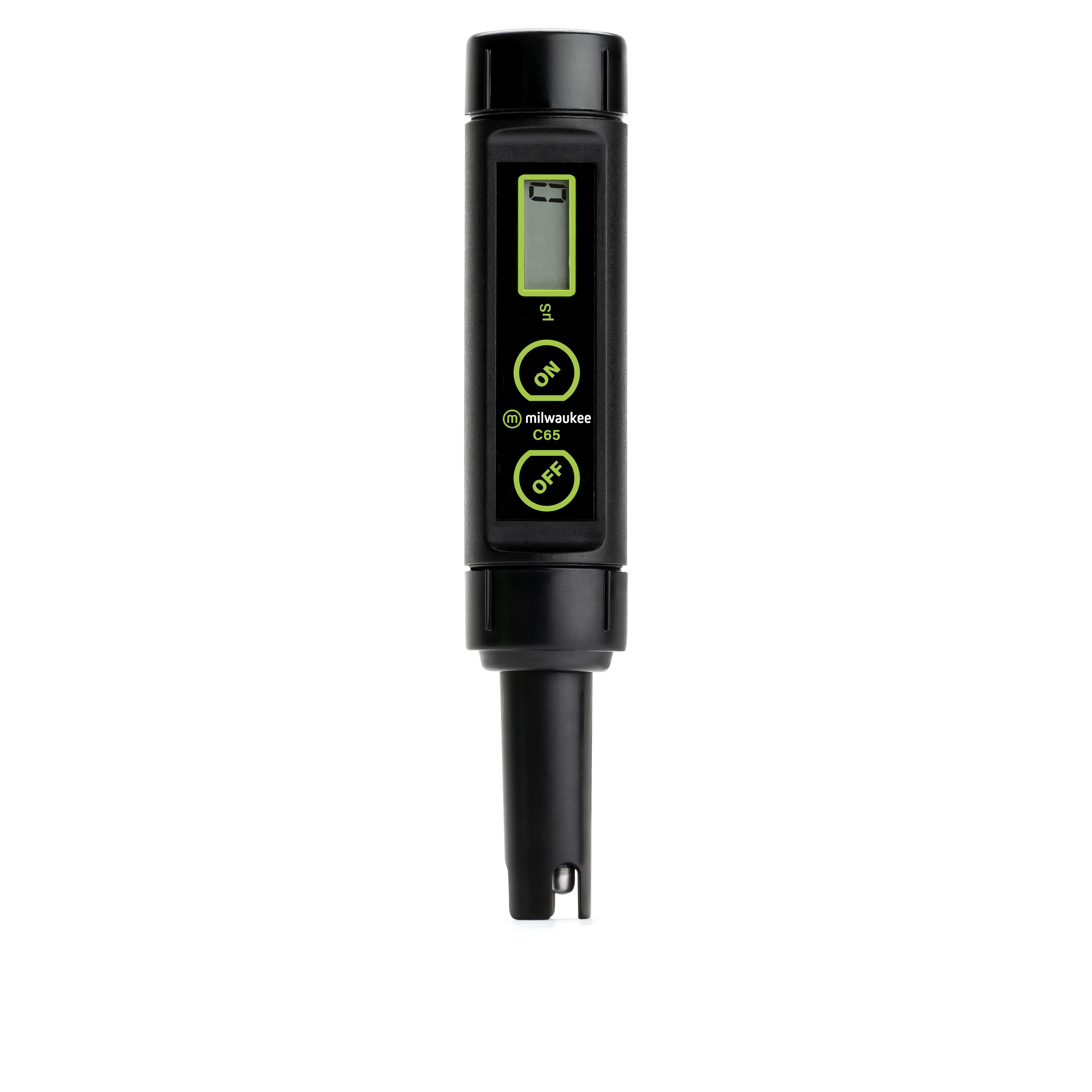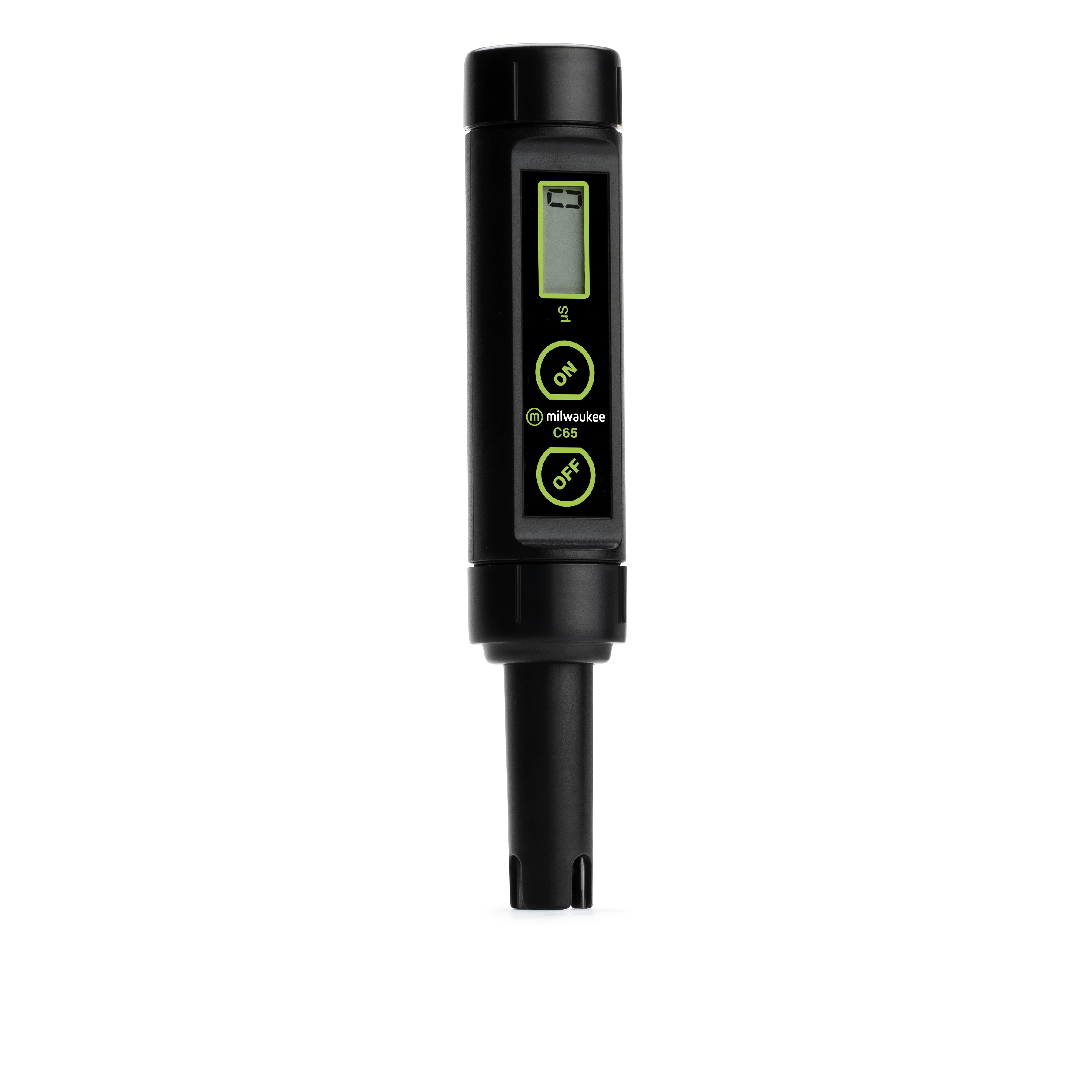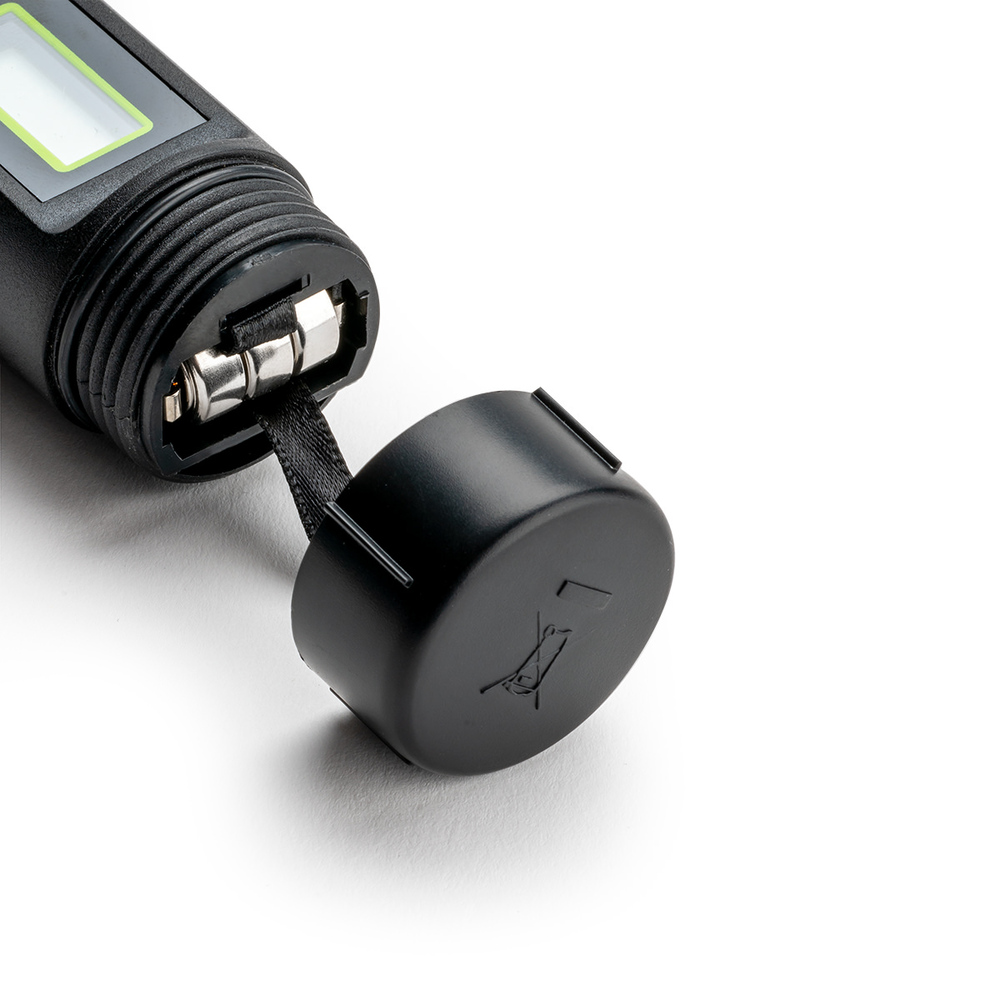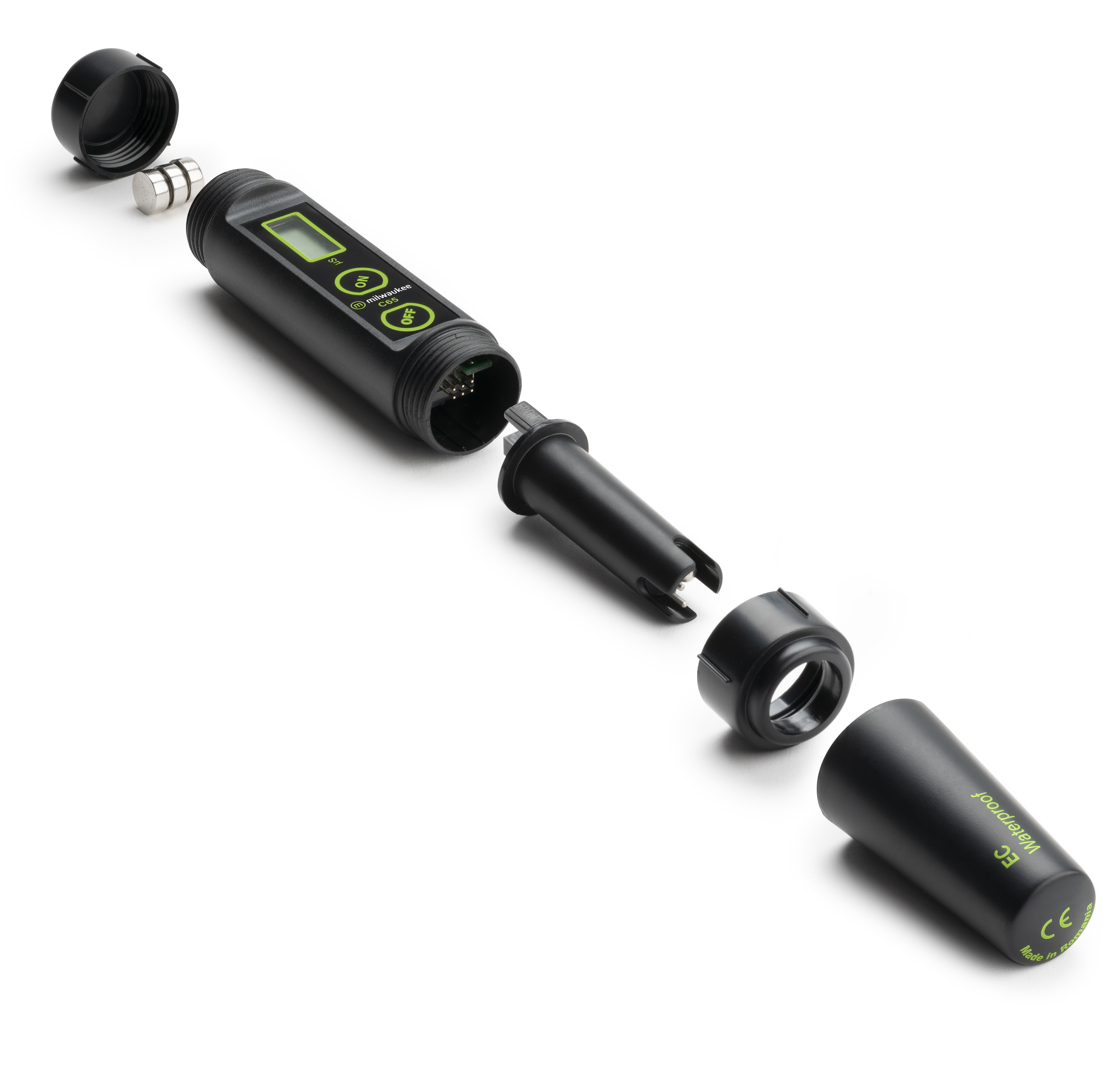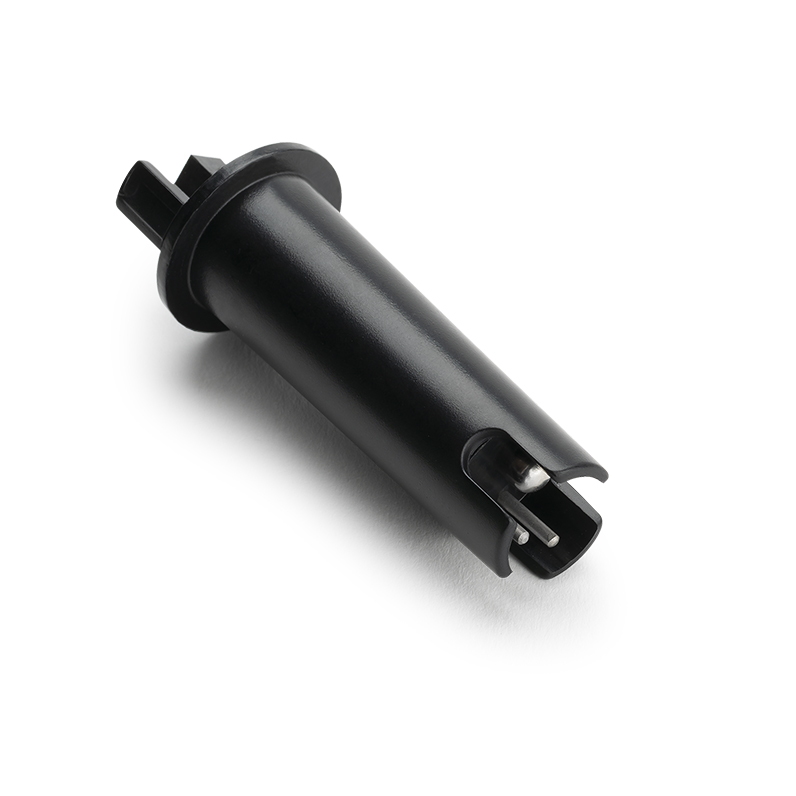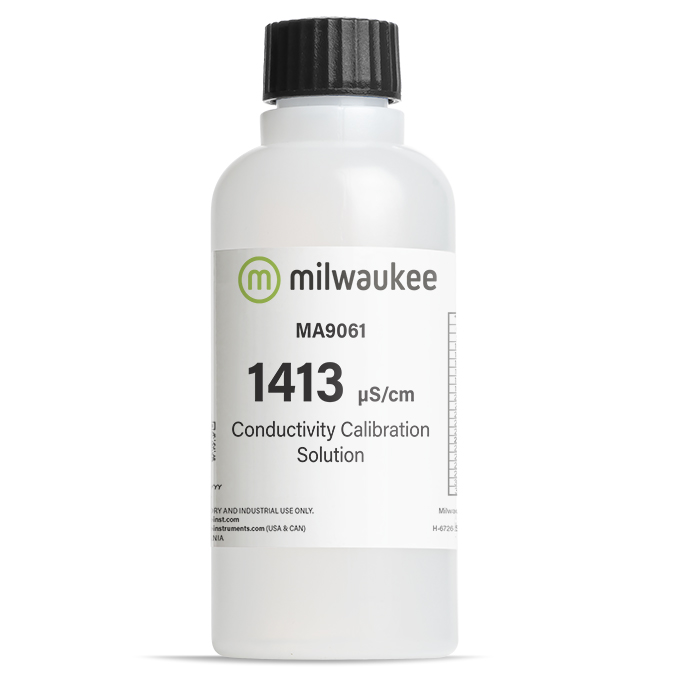Your shopping cart is currently empty.
€48.13
Milwaukee C65 Low Range Waterproof Conductivity Pen with ATC and Replaceable Electrode
Milwaukee C65 Low Range Waterproof Conductivity Pen with ATC and Replaceable Electrode – Precision at Your Fingertips for Everyday Water Monitoring
Whether you're managing a hydroponic system, fine-tuning an aquarium, or checking the quality of irrigation water, precision matters. Even small shifts in water conductivity can significantly impact plant health, aquatic life, or process outcomes. That’s where the Milwaukee C65 comes in – your trusted tool for fast, accurate EC and temperature measurements in low-range environments.
Designed for professionals and serious hobbyists alike, the C65 delivers reliable results right where you need them: in the greenhouse, the classroom, the lab, or in the field. Its low-range EC measurement (0–1999 µS/cm) makes it ideal for freshwater applications, hydroponic nutrient solutions, and irrigation water testing, while the built-in Automatic Temperature Compensation (ATC) ensures accuracy across changing conditions. With a waterproof body and replaceable electrode, this portable meter is built for repeatable performance in real-world conditions.
From agriculture to aquaculture, education to industrial water systems, the C65 offers reliable, user-friendly conductivity testing – backed by Milwaukee’s commitment to quality.
Why Choose the Milwaukee C65?
- Low-Range
Precision
Accurately measures conductivity from 0 to 1999 µS/cm, making it perfect for applications where even small changes in EC matter. - Automatic
Temperature Compensation (ATC)
Delivers consistent readings regardless of water temperature, ensuring data you can trust. - Replaceable
Electrode
Extends the life of the device while keeping long-term ownership costs low. - Waterproof
& Durable Design
IP65-rated for use in humid, wet, or outdoor environments – ideal for greenhouses, farms, or fish tanks. - Compact
and Portable
Lightweight and pocket-sized for on-the-go testing without sacrificing performance. - Easy
Calibration
Simple one-point manual calibration ensures accuracy with minimal effort.
Applications of the Milwaukee C65
- Hydroponics
Maintain nutrient solution balance for optimal plant growth and yield. - Aquariums
Monitor EC levels to ensure a stable environment for aquatic life. - Aquaculture
Track water salinity and nutrient levels for healthy fish and shellfish farming. - Agriculture
& Irrigation
Check water salinity to prevent soil damage and support healthy crop production. - Swimming
Pools
Ensure balanced water chemistry for safety and comfort. - Education
A perfect tool for teaching water quality, chemistry, and environmental science in classrooms and labs. - Food
& Beverage
Monitor water purity and conductivity in production and cleaning processes. - Industrial
Water Treatment
Keep water systems within desired conductivity ranges to avoid corrosion and scaling.
Proper Care & Maintenance
To ensure the best performance and extend the life of your Milwaukee C65 Low Range Waterproof Conductivity Pen, follow these essential care guidelines:
Rinse After Every Use
EC electrodes can develop nutrient or residue buildup over time. To minimize this, always rinse the probe in fresh tap water or distilled/deionized (DI) water after each measurement. This helps prevent contamination and ensures stable readings.
Calibrate Regularly
Regular calibration is key to maintaining measurement accuracy. Use a certified EC calibration solution and recalibrate weekly if used frequently. One-point manual calibration makes the process quick and simple.
Replace the Electrode When Needed
If your readings become inconsistent or response times slow down, it may be time to replace the electrode. With the C65’s replaceable electrode design, you can restore full performance without needing to replace the entire device.
Store Properly
When not in use, store the C65 in a dry location at room temperature. Avoid exposing it to direct sunlight, excessive heat, or cold to preserve battery life and probe sensitivity.
Understanding EC & TDS Conversion
The Milwaukee C65 measures electrical conductivity (EC), an absolute measurement of ion concentration in a solution. However, EC values are often converted to TDS (Total Dissolved Solids) in parts per million (ppm) for practical purposes.
Different conversion scales exist, and it's important to know which one applies to your process:
- 0.5
Factor Scale:
1 µS/cm = 0.5 ppm - 0.7
Factor Scale (442 Scale):
1 µS/cm = 0.7 ppm
Note: These are approximations. True TDS can only be determined through chemical analysis, as EC meters measure the concentration of charged ions – not their specific chemical makeup.
Compact. Accurate. Built to last.
Trust the Milwaukee C65 to deliver dependable EC and temperature
measurements – wherever your work takes you.
Specifications
Application
Aquariums & Aquaculture
Whether you're nurturing a vibrant home aquarium or managing a commercial fish farming operation, water quality is the foundation of aquatic health. Among the most important parameters to monitor is electrical conductivity (EC) – a direct indicator of the concentration of dissolved salts and minerals in water.
In freshwater aquariums, EC helps assess water hardness and mineral balance, both of which are critical for the well-being of fish, shrimp, and aquatic plants. Stable EC supports proper osmoregulation in fish, ensures nutrient availability for plants, and prevents filter bacteria from becoming stressed.
In aquaculture, where fish or shrimp are raised in high densities, EC plays a vital role in maintaining a safe and stable environment. Sudden changes in water salinity or nutrient levels can cause stress, reduce growth rates, and increase mortality. Regular EC monitoring allows farm operators to:
· Maintain optimal salinity levels for different species (freshwater, brackish, or marine)
· Ensure consistent mineral content that supports fish metabolism and immune function
· Monitor the impact of feed inputs, water exchanges, and environmental conditions
· Prevent costly water quality imbalances that can threaten entire stocks
The Milwaukee C65 Low Range Waterproof Conductivity Pen with ATC and Replaceable Electrode is ideal for both applications. With its precision range of 0 to 1999 µS/cm and automatic temperature compensation, it provides fast, reliable data to help aquarists and aquaculture professionals take proactive action before issues arise.
How to Use the Milwaukee C65 in Aquariums & Aquaculture
1. Calibrate the Pen
Use a certified EC calibration solution (e.g., 1413 µS/cm) before first use or
on a regular schedule to ensure accurate readings.
2. Rinse the Electrode
Always rinse the electrode with tap or distilled water to remove any
contaminants.
3. Take a Measurement
· Submerge the electrode into the tank, pond, or water sample container.
· Gently stir the water around the probe tip to eliminate air bubbles.
· Wait for the reading to stabilize. The EC value will automatically compensate for temperature.
4. Interpret the Reading
· Compare the reading to your ideal EC range:
Freshwater aquariums: typically 100–800 µS/cm
Aquaculture systems: species-specific, often between 500–1500 µS/cm depending on salinity targets
· Adjust water conditions as needed: water changes, mineral supplements, or feed adjustments.
5. After Testing
· Rinse the probe thoroughly with fresh water.
· Turn off the meter and store it in a clean, dry place.
By integrating EC monitoring into your routine, you can ensure a stable, healthy environment for aquatic life – whether you're caring for a few ornamental fish or managing a full-scale aquaculture operation. The Milwaukee C65 helps you stay ahead of water quality challenges with speed, accuracy, and confidence.
Agriculture & Irrigation
In modern agriculture, understanding water quality is just as important as soil health or fertilization strategy. One of the key water quality indicators is electrical conductivity (EC), which reflects the concentration of dissolved salts (salinity) in irrigation water.
High salinity levels can lead to:
· Salt buildup in soil, which interferes with nutrient uptake
· Osmotic stress in plants, making it harder for roots to absorb water
· Reduced crop yields and long-term soil degradation
On the other hand, very low EC may signal insufficient nutrient levels in fertigation systems, leading to nutrient deficiencies.
The Milwaukee C65 Low Range Waterproof Conductivity Pen with ATC and Replaceable Electrode offers a fast and portable way for farmers to monitor EC in their irrigation water – whether they're pulling from a well, canal, reservoir, or using recycled water. With a measurement range of 0–1999 µS/cm, the C65 is perfect for evaluating salinity levels in:
· Drip irrigation systems
· Greenhouses and open fields
· Hydroponic or fertigation setups
· Drainage or runoff water
Regular EC testing helps identify water sources that may cause long-term soil damage and allows growers to adjust their practices before salinity becomes a problem. It’s a simple way to safeguard crops, maximize yields, and make smarter fertilization decisions.
How to Use the Milwaukee C65 in Agriculture & Irrigation
1. Calibrate the Meter
· Use a certified EC calibration solution (e.g., 1413 µS/cm) before the first use and regularly thereafter.
· Calibration ensures accuracy, especially when used across different water sources.
2. Collect Your Water Sample
· Take a sample from the irrigation source (e.g., drip line, tank, well, or channel) into a clean container.
· For fertigation systems, take samples before and after fertilizer dosing for comparison.
3. Rinse the Probe
· Rinse the C65 electrode with tap or distilled water to avoid contamination from previous readings.
4. Take the Measurement
· Submerge the electrode into the sample.
· Swirl gently to remove any trapped air bubbles.
· Wait for the reading to stabilize – usually within seconds.
· The display will show the EC value in µS/cm, temperature-compensated automatically.
5. Interpret the Results
· Compare the EC value to your target range.
Freshwater irrigation: typically 0–750 µS/cm
Fertigation: can vary depending on crop type and nutrient solution (consult agronomic guidelines)
· If EC is too high, consider diluting the water, improving drainage, or flushing the soil.
· If EC is too low in fertigation, adjust your nutrient concentrations.
6. After Use
· Rinse the electrode again and store the pen in a clean, dry place.
Swimming Pools
Maintaining crystal-clear, safe water in swimming pools isn’t just about pH and chlorine—electrical conductivity (EC) is also a critical yet often overlooked parameter. EC reflects the total concentration of dissolved salts and minerals in pool water, giving you insight into water balance, sanitation effectiveness, and the long-term health of the pool system.
Over time, as water evaporates and chemicals are added (chlorine, algaecides, shock treatments), the TDS (total dissolved solids) level increases. Since TDS can't be removed through chemical treatment alone, it accumulates and can cause:
· Cloudy water
· Irritated eyes and skin
· Reduced sanitizer effectiveness
· Scaling or corrosion of pool surfaces and equipment
The Milwaukee C65 Low Range Waterproof Conductivity Pen with ATC and Replaceable Electrode helps pool owners and maintenance professionals detect these changes early. By measuring EC, which correlates directly with TDS, you get a quick snapshot of your pool’s chemical load and can decide when a partial or complete water change is necessary – before problems arise.
Its compact size, waterproof build, and easy calibration make the C65 a practical tool for poolside checks, especially in private backyard pools, commercial facilities, or hotel spas.
How to Use the Milwaukee C65 in Swimming Pools
1. Calibrate the Meter
· Before first use and at regular intervals, calibrate the C65 using a certified EC calibration solution (e.g., 1413 µS/cm).
· Proper calibration ensures reliable readings across all water types.
2. Prepare for Testing
· Rinse the electrode with tap or distilled water to remove residues or contaminants.
3. Take the Measurement
· Dip the probe into the pool water at about elbow depth.
· Avoid areas near return jets or skimmers to get a more representative reading.
· Swirl gently and allow the reading to stabilize (usually takes a few seconds).
· The EC value in µS/cm will be automatically temperature-compensated and shown on the screen.
4. Interpret the Results
· Compare the reading with general pool water guidelines:
· Ideal EC range: ~500–2000 µS/cm (this may vary depending on fill water, sanitizer type, and pool system)
· EC values consistently rising over time suggest increasing TDS and potential need for dilution.
· If EC is too high:
· Consider a partial water replacement to reduce mineral load.
· Monitor chlorine effectiveness, as high TDS can reduce its performance.
5. After Testing
· Rinse the electrode with fresh water.
· Turn off the meter and store it in a dry, cool place.
By regularly measuring EC with the Milwaukee C65, pool owners can go beyond surface-level water checks and gain a deeper understanding of total water balance. It’s a simple step that supports cleaner water, longer-lasting equipment, and a safer swimming experience for everyone.
Hydroponics
In hydroponics, plants rely entirely on water-based nutrient solutions for survival. Unlike traditional soil-grown crops, hydroponic plants don’t have a buffering medium – which means nutrient levels must be precisely managed to avoid under- or overfeeding.
That’s where electrical conductivity (EC) comes in. EC provides a fast and reliable indicator of total dissolved salts (nutrient concentration) in your solution. If EC is too low, plants may suffer from nutrient deficiencies. If it’s too high, the excess salts can cause osmotic stress, burning roots and stunting growth.
The Milwaukee C65 Low Range Waterproof Conductivity Pen with ATC and Replaceable Electrode is purpose-built for growers who need accurate EC monitoring in small to mid-sized hydroponic setups. With a range of 0 to 1999 µS/cm, it covers the ideal conductivity window for most leafy greens, herbs, and fruiting crops. It also features automatic temperature compensation (ATC) to ensure consistent readings – even when nutrient tanks are exposed to temperature swings in greenhouses or grow tents.
By integrating daily EC checks into your growing routine, you can:
· Ensure consistent nutrient availability
· Adjust feed strength based on plant stage (seedling, veg, bloom)
· Catch imbalances early before symptoms appear
· Improve crop yield, flavor, and quality
· Minimize waste and nutrient runoff
Whether you're growing lettuce in an NFT system or tomatoes in deep water culture, the C65 is a must-have tool for any grower aiming to master nutrient control.
How to Use the Milwaukee C65 in Hydroponics
1. Calibrate the Meter
· Calibrate with a standard EC calibration solution (e.g., 1413 µS/cm).
· Regular calibration ensures accurate readings, especially when switching between reservoirs or systems.
2. Rinse the Probe
· Before each use, rinse the electrode with distilled or clean tap water to prevent cross-contamination.
3. Take a Sample or Test Directly
· You can either dip the meter directly into your reservoir or collect a small sample in a clean container.
· Gently swirl the probe in the nutrient solution to remove air bubbles.
4. Read the EC Value
· Wait for the reading to stabilize.
· The Milwaukee C65 will display the EC value in µS/cm, automatically adjusted for temperature via ATC.
5. Compare to Your Target Range
General EC guidelines by crop stage (can vary by plant type):
· Seedlings/Clones: 400–800 µS/cm
· Vegetative Stage: 800–1200 µS/cm
· Flowering/Fruiting: 1000–1600 µS/cm
⚠️ Always refer to crop-specific EC guidelines to avoid over- or underfeeding.
6. Make Adjustments if Needed
· If EC is too low, increase nutrient concentration or top up with a stronger solution.
· If EC is too high, dilute the solution by adding clean water.
7. After Use
· Rinse the electrode with clean water.
· Turn off the meter and store it in a dry, room-temperature environment.
By using the Milwaukee C65 in your hydroponic system, you're not just testing – you're gaining control over your plant's entire nutritional environment. With accurate EC data in hand, you can feed with precision, prevent problems, and grow with confidence.
Education
Whether in a high school chemistry lab, a university environmental science course, or a field-based research project, hands-on learning is essential for helping students understand the science behind water quality. The Milwaukee C65 Low Range Waterproof Conductivity Pen with ATC and Replaceable Electrode is an ideal educational tool for teaching the principles of electrical conductivity (EC), salinity, and temperature compensation – core topics in chemistry, biology, geography, and environmental engineering.
Unlike theoretical data, real-world measurements help students:
· Understand how EC relates to ion concentration in water
· Explore the relationship between salinity, mineral content, and conductivity
· Compare freshwater and saltwater systems
· Investigate environmental impacts like pollution, runoff, or irrigation practices
· Analyze how temperature affects water chemistry via ATC (Automatic Temperature Compensation)
The Milwaukee C65 is rugged, portable, and easy to use, making it perfect for:
· Classroom demonstrations
· Laboratory experiments
· Fieldwork at rivers, lakes, or wetlands
· Science fair projects and STEM programs
Its 0–1999 µS/cm measurement range aligns well with most freshwater studies and educational environments, offering the precision needed to reinforce core scientific concepts without overcomplicating the learning experience.
How to Use the Milwaukee C65 in Educational Settings
1. Prepare for the Lesson
· Before class or fieldwork, ensure the meter is calibrated using a certified EC calibration solution (e.g., 1413 µS/cm).
· If you're conducting a group activity, provide a brief overview of EC, ion concentration, and how dissolved salts affect water conductivity.
2. Rinse the Probe
· Rinse the electrode with tap or distilled water before each group uses it. This prevents cross-contamination between samples.
3. Take Measurements
· Instruct students to submerge the probe into their water sample (e.g., tap water, pond water, bottled water, saltwater solution).
· Have them gently swirl the sample around the probe tip and wait for the display to stabilize.
· The Milwaukee C65 will show the EC value in µS/cm, which is automatically adjusted for temperature.
4. Analyze the Data
Students can:
· Compare EC values across different water types
· Observe how temperature affects conductivity using cold vs. warm samples
· Relate EC to water quality – e.g., clean vs. polluted, distilled vs. mineral water
· Practice converting EC to TDS using 0.5 or 0.7 factor scales for ppm estimation
Example: 1 µS/cm ≈ 0.5 ppm (500 scale)
5. Discuss Findings
· Lead a discussion on what high or low EC means in environmental and practical contexts (e.g., aquatic life, drinking water, irrigation).
· Connect readings to real-world applications: agriculture, aquaculture, hydroponics, industry.
6. After Use
· Rinse the probe thoroughly with fresh water.
· Turn off the device and store it safely in a dry, cool area.
By using the Milwaukee C65 in an educational context, students don’t just memorize concepts – they experience them. It transforms abstract topics like conductivity and ion concentration into visible, testable, and engaging science. Whether for a short classroom demo or a full lab module, it’s a compact and powerful way to bring science to life.
Industrial Water Treatment
In industrial settings – from manufacturing plants and cooling towers to boiler systems and water treatment facilities – water quality directly affects performance, safety, and compliance. One of the most critical parameters in this context is electrical conductivity (EC), which provides a fast, reliable measure of the concentration of dissolved ionic substances such as salts, minerals, and treatment chemicals.
If the EC levels in water used for industrial processes are too high, this can result in:
- Scaling on pipes, heat exchangers, and pumps
- Corrosion of equipment and infrastructure
- Reduced system efficiency and higher energy costs
- Process inconsistencies or contamination risks
- Regulatory non-compliance, especially in wastewater discharge
If EC levels are too low, it may signal poor dosing of treatment chemicals or excessive dilution – both of which can compromise water performance and increase operational costs.
The Milwaukee C65 Low Range Waterproof Conductivity Pen with ATC and Replaceable Electrode offers a portable, user-friendly solution for quickly checking EC levels at various points in an industrial system. With a range of 0 to 1999 µS/cm, it's best suited for freshwater applications, treated water, and low-conductivity process streams – providing a fast way to troubleshoot issues or verify that automated systems are functioning properly.
How to Use the Milwaukee C65 in Industrial Water Treatment
1. Calibrate the Meter
· Use a certified EC calibration solution (e.g., 1413 µS/cm) before the first use and regularly based on usage frequency or SOPs.
· For industrial QA/QC, calibration should be part of the routine inspection checklist.
2. Prepare the Probe
· Rinse the electrode with distilled or deionized water to remove any prior residue and avoid cross-contamination between testing points.
3. Collect or Access the Sample
· Either test directly in process tanks or collect water samples from inspection points, cooling loops, or discharge lines.
· For safety, always follow site-specific procedures and wear appropriate PPE when collecting industrial water samples.
4. Take the Reading
· Submerge the electrode in the sample and gently swirl the probe to eliminate air bubbles.
· Wait for the reading to stabilize – typically within seconds.
· The meter will display the EC value in µS/cm, automatically adjusted for temperature via ATC.
5. Interpret the Results
· Compare the reading to your internal benchmarks or regulatory limits:
Boiler feedwater: often under 1000 µS/cm depending on system requirements
Cooling tower blowdown: variable, but frequently monitored to control cycles of concentration
Treated wastewater discharge: must comply with local environmental limits on TDS and EC
· Use the reading to:
Adjust chemical dosing
Trigger water changes or system flushes
Verify regeneration cycles for ion exchange or RO systems
6. After Testing
· Rinse the electrode with clean water to remove any chemical residues.
· Dry and store the meter in a clean, controlled location away from harsh chemicals or heat sources.
The Milwaukee C65 allows industrial teams to react quickly to potential issues in water quality – without waiting for lab results or relying solely on automated systems. Its precision, portability, and rugged design make it an essential tool for preventive maintenance, compliance monitoring, and on-the-spot troubleshooting across a wide range of industries.
Food & Beverage
In the food and beverage industry, water isn’t just an ingredient – it’s an essential part of every process, from mixing and cooking to cleaning and sanitation. Ensuring water quality and consistency is vital for maintaining product standards, regulatory compliance, and food safety.
One key metric for assessing water quality and cleaning solution strength is electrical conductivity (EC). EC measures the concentration of dissolved ions in a liquid, making it a fast and reliable indicator of:
· Purity of water used in production or rinsing
· Proper concentration of cleaning or sanitizing solutions
· Residual salts or chemicals on surfaces or in final rinse cycles
· Consistency of brine, syrups, or process water used in recipes
By monitoring EC at key points in the production or CIP (clean-in-place) cycle, manufacturers can:
· Verify that deionized or reverse osmosis water meets required standards
· Confirm that detergent or sanitizer concentrations are within effective (and safe) ranges
· Reduce chemical waste and optimize water usage
· Prevent cross-contamination or product quality issues
The Milwaukee C65 Low Range Waterproof Conductivity Pen with ATC and Replaceable Electrode offers a compact, rugged, and easy-to-use solution for on-the-spot checks – ideal for food processors, beverage bottlers, breweries, dairies, and commercial kitchens.
How to Use the Milwaukee C65 in Food & Beverage Applications
1. Calibrate the Meter
· Use a certified EC calibration solution (e.g., 1413 µS/cm) to ensure reliable readings.
· For quality assurance procedures, calibrate daily or before each shift depending on your SOP.
2. Rinse the Electrode
· Rinse the probe with distilled water before and after testing to avoid cross-contamination – especially important when measuring different solutions (e.g., between rinse water and sanitizer).
3. Take the Measurement
· Submerge the probe in the sample (e.g., process water, final rinse, sanitizer bath, or ingredient solution).
· Gently swirl the solution to remove air bubbles.
· Wait a few seconds for the reading to stabilize. The EC value in µS/cm will be displayed and automatically temperature-compensated (ATC).
4. Interpret the Reading
Depending on your application:
· DI/RO water should show very low EC (typically <10 µS/cm)
· Sanitizer solutions (like quaternary ammonium or chlorine-based) have defined EC ranges for effectiveness – check against manufacturer guidelines
· Rinse water after CIP should return to near-baseline EC values to confirm the system is free from chemical residues
· Ingredient solutions (e.g., syrups or brines) can be monitored for batch consistency and recipe accuracy
5. Record and Respond
· Log the EC readings as part of your QA documentation.
· Adjust chemical concentrations, perform re-rinses, or troubleshoot abnormal EC values as needed.
6. After Testing
· Rinse the electrode thoroughly with distilled or clean water.
· Turn off the unit and store it in a dry, clean environment away from food contact areas.
By integrating the Milwaukee C65 into routine monitoring, food and beverage facilities can ensure clean, consistent, and compliant processes – from incoming water quality to final rinse verification. It’s a simple tool that adds big value to daily quality assurance practices.




